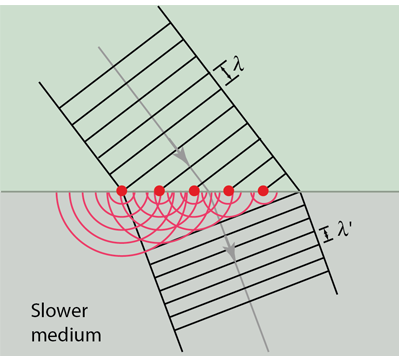Huygens' Principle
 | In 1678 Huygens proposed a model where each point on a wavefront may be regarded as a source of waves expanding from that point. The expanding waves may be demonstrated in a ripple tank by sending plane waves toward a barrier with a small opening. If waves approaching a beach strike a barrier with a small opening, the waves may be seen to expand from the opening. |
| Huygens' principle provides a convenient way to visualize refraction. If points on the wavefront at the boundary of a different medium serve as sources for the propagating light, one can see why the direction of the light propagation changes. |  |
 | The Huygens' principle view permitted a visualization of how light could penetrate into the geometric shadow in a way that the particle view could not. |
Though helpful in establishing a wave view rather than a particle view of light for ordinary optics, Huygens' principle left a number of unanswered questions. For example, with its view of each point on a wavefront as a source, it gave no explanation of why it didn't propagate backward as well as forward. Miller and Fresnel further developed the theory of light propagation including diffraction. The theory of light propagation was made more rigorous by Kirchhoff.
|
Index |


